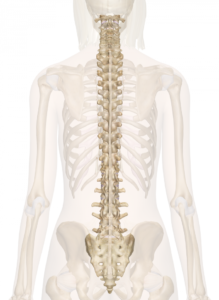 A healthy spine is the key to a vibrant life. Yogis, Osteopaths, Chiropractors, and many doctors agree that you are as young as your spine is flexible. Unfortunately, back pain has become an epidemic in our culture. This is mainly due to poor posture, weak back musculature, and limited movement in the spine.
A healthy spine is the key to a vibrant life. Yogis, Osteopaths, Chiropractors, and many doctors agree that you are as young as your spine is flexible. Unfortunately, back pain has become an epidemic in our culture. This is mainly due to poor posture, weak back musculature, and limited movement in the spine.
The spine has a few critical functions. First, it is your central column of support. It stabilizes your body and holds you up against gravity. Building strength in the muscles that sleeve your spine is important to support good posture, keep you powerful during life’s activities, and prevent injury.
Your spine also houses your spinal cord. Think of it this way – your brain is not just in your head. You have so much brain that it flows all the way down your spine. Nerve endings exit from every one of your spinal bones called vertebras. This system, called your central nervous system, is the highway that carries information to every cell, muscle fiber, and organ in your body. A fluid spine is key for a clear road of communication throughout your body – an open pathway for oxygen and nutrients to flow.
But these days, many people’s spines are rigid, posture is rounded forward, and core is weak. I have good news for you – backbends are one of the antidotes! When you have back pain, it seems counterintuitive to do a backbend. But in reality, it is backbends that will help you strengthen your back muscles, improve the mobility of the bones of your spine, and promote the health of the discs that lie between each spinal vertebra. It is the opposite of the way you spend most of your day. Of course, like anything else, backbends need to be done correctly to be beneficial.
Let’s take a look at your spine. You may notice that you have the most mobility in your lower back (lumbar spine) and your neck (cervical spine). Interestingly enough these are the places you may commonly experience pain. Pain is often a symptom of lack of stability.
Your lumbar spine is meant to be stable and 
carry the load of your body as you move through the world. In general we move too much in the lower back simply because we have more access to it. It doesn’t have all those ribs attached to it! The lumbar spine relies on support from deeper postural core muscles like transverse abdominis and multifidus to create stability. These crucial postural muscles tend to be weak.
Your middle back, called the thoracic spine, is meant to move in many directions: forward, backwards, laterally, and it rotates. Unfortunately it is often locked down and doesn’t move enough. A rounded upper back and forward head position is common because life happens in front of you: sitting in front of a computer, behind the wheel, cooking, caring for children, you name it, most things in life are a culprit.
BENEFITS OF BACKBENDS:
- Improves posture
- Strengthens back muscles
- Opens chest and shoulders
- Stretches respiratory diaphragm
- Helps you breathe better
- Stimulates digestion
- Counters depression
- Clears mind and opens heart
- Boosts energy
- Alleviates fear
- Aids in overcoming emotional challenges
Please consider joining me for my next workshop, Build A Healthy and Strong Backbend.
Backbends are empowering! All backbends are rooted in Bhujangasana, Cobra Pose. Learning to skillfully perform a deeper cobra, with strength and support first, is the key to bending evenly and feeling better in your backbends. This is where the fancier poses begin.
If you are intimidated by backbends, this will be a great opportunity for you to focus on your spine and improve your posture. It’s more about YOU and less about any of the poses! If you already backbend with ease, this workshop will help you refine your backbends. You will learn to stabilize your spine where you move too much, and mobilize the places where you don’t move enough.
For everyone, this will help you create a sustainable practice to last throughout your lifetime. And who knows, once you learn the basics, you may just get into that advanced backbend you have been struggling with.

Leave a Reply